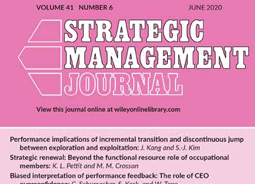
Performance implications of incremental transition and discontinuous jump between exploration and exploitation
김상준 (s.kim@ewha.ac.kr)
경영학부

Prof. Sang-Joon Kim’s recent research published in Strategic Management Journal, entitled “Performance implications of incremental transition and discontinuous jump between exploration and exploitation,” is about organizational vacillation between exploration (i.e. creating new knowledge) and exploitation (i.e. improving existing knowledge). While prior literature on exploration and exploitation has touched upon how firms balance these two different approaches (March, 1991), organizational vacillation views how firms dynamically make use of old ideas and search for new ideas to remain competitive. Inspired by Nickerson & Zenger (2002), Prof. Kim, with Prof. Jingoo Kang, Nanyang Technological University, Singapore, has been interested in figuring out performance implications of temporal transition between exploration and exploitation. Prior to this study, they published a research article on how sequentially-constructed exploration-exploitation configurations, i.e. organizational vacillation, affect financial performance (see Kang, Kang, Kim, 2017). Acknowledged as the first attempt to empirically examine the outcomes of the firm actions related to organizational vacillation, the prior study focused on the vacillation patterns and their performance implications. In this current piece, as a sequel, the organizational vacillation, reframed as temporal transition, is juxtaposed into incremental transition and discontinuous jump. This juxtaposition is drawn from the theoretical gap between temporal ambidexterity (a way to simultaneously achieve exploration and exploitation over time) and punctuated equilibrium (exclusive periods of exploration and exploitation). Accordingly, temporal transition discerns between firm actions which alternate between old and new ideas in an incremental and continuous manner perform and those which switch abruptly between old and new ideas. And given this juxtaposition, this study answers the question as to how firms perform a temporal transition and empirically tests performance implications of these two types of temporal transition.
Furthermore, acknowledging that the performance effects of the two approaches are more pronounced for firms with limited resources, the authors highlight the importance of firm resources and particularly that of non-scale-free resources in a temporal transition. While scale-free resources can be used indefinitely for other uses and always have excess capacity, non-scale-free resources, subject to the opportunity cost and allocation problem, impose a particularly significant constraint on a firm's ability to alternate between exploration and exploitation.
To test these ideas related to temporal transition between exploration and exploitation, the authors build up unbalanced panel data consisting of 32,880 time-series observations of US firms from 1983 to 2007 by using multiple databases, such as Compustat, CRSP, and USPTO patent databases. The dependent variable is captured with Tobin’s q. The measure of a temporal transition between exploration and exploitation is based on the given firm's patenting behaviors. Exploration is operationalized with the patents filed during a given year and in technical classifications for which the focal firm has not historically filed while exploitation is captured with the patents filed in a year and in technical classifications for which the focal firm has historically filed. By figuring out how the relative dominance between exploration and exploitation is changed over time, a temporal transition is identified and classified into incremental transition and discontinuous jump, which are the main predictors of this study. For a moderator, non-scale-free resource is measured in terms of technological resources, instantiated by R&D budget, and financial resources, measured by free cash flow.
With the measures, the authors run firm and year fixed effects regressions and find that a discontinuous jump has a negative effect on firm performance while an incremental transition has a positive effect. And the performance effects of the two approaches are more pronounced for firms with limited resources. This indicates that the role of firm resources and particularly that of non-scale-free resources is critical in shaping the performance effects of the two types of temporal transition. These findings indicate that the two types of temporal transition have distinct advantages and disadvantages.
Theoretically, this study contributes to the literature on temporal transition and ambidexterity by more precisely defining a temporal transition, theorizing on the advantages and disadvantages of different types of temporal transition, and providing rare large-sample statistical evidence for the performance implications of a temporal transition. Along with this, practically, this study warns managers of the danger of an abrupt and discontinuous jump between old and new ideas, especially for firms with limited resources.
This study seems just a small piece on temporal transition and its performance implications. Given that the difference between a discontinuous jump and an incremental transition has been understood, the next step would be to identify a more complete set of boundary conditions for different types of temporal transition. There are both internal and external contingencies that could explain when and under what circumstances firms may deal more effectively with a discontinuous jump and an incremental transition. This might be what we expect from Prof Kim’s future research.
* Related Article
Kang, J., & Kim, S. J. (2020). Performance implications of incremental transition and discontinuous jump between exploration and exploitation, Strategic Management Journal, 41(6), 1083-1111.
* References
Kang, J., Kang, R., & Kim, S.-J. (2017). An empirical examination of vacillation theory. Strategic Management Journal, 38(6), 1356–1370.
March, J. G. (1991). Exploration and exploitation in organizational learning. Organization Science, 2(1), 71–87.
Nickerson, J. A., & Zenger, T. R. (2002). Being efficiently fickle: A dynamic theory of organizational choice. Organization Science, 13(5), 547–566.
